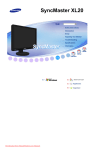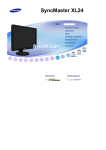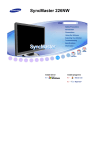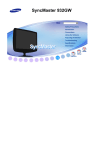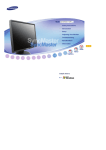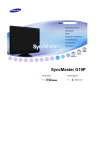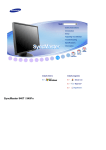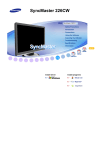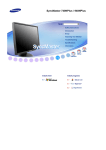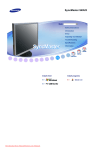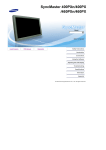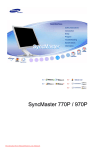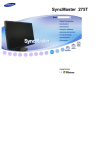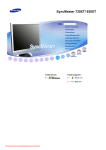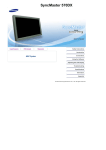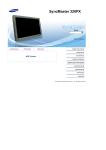Download Samsung XL20 User Manual
Transcript
SyncMaster XL20
SyncMaster XL20
Model
SyncMaster XL20
Notational
Failure to follow directions noted by this symbol could result in bodily harm or damage to
the equipment.
Prohibited
Important to read and understand at all times
Do not disassemble
Disconnect the plug from the outlet
Do not touch
Ground to prevent an electric shock
Power
When not used for an extended period of time, set your computer to DPMS.
If using a screen saver, set it to active screen mode.
Do not use a damaged or loose plug.
z
This may cause electric shock or fire.
Do not pull the plug out by the wire nor touch the plug with wet hands.
z
This may cause electric shock or fire.
Use only a properly grounded plug and receptacle.
z
An improper ground may cause electric shock or equipment damage.
Insert the power plug firmly so that it does not come loose.
z
A bad connection may cause fire.
Do not excessively bend the plug and wire nor place heavy objects upon
them, which could cause damage.
z
This may cause electric shock or fire.
Do not connect too many extension cords or plugs to one outlet.
z
This may cause fire.
Do not disconnect the power cord while using the monitor.
z
A surge may be caused by the separation and may damage the monitor.
Do not use the power cord when the connector or plug is dusty.
z
z
Installation
If the connector or plug of the power cord is dusty, clean it with a dry
cloth.
Using the power cord with a dusty plug or connector may cause an
electric shock or fire.
Be sure to contact an authorized Service Center, when installing your monitor in
a location with heavy dust, high or low temperatures, high humidity, and exposed
to chemical substances and where it operates for 24 hours such as at airports,
train stations etc.
Failure to do so may cause serious damage to your monitor.
Place your monitor in a location with low humidity and a minimum of
dust.
z
Failure to do so may cause electric shock or fire inside the monitor.
Do not drop the monitor when moving it.
z
This may cause damage to the product or the person carrying it.
Install the monitor base in a showcase or shelf so that the end of the
base does not protrude from the showcase or shelf.
z
Dropping the product may cause a malfunction or injury to the person
carrying it.
Do not place the product on an unstable or small surface area.
z
Place the product on an even and stable surface, as the product may fall
and cause harm to someone walking by, specifically children.
Do not place the product on the floor.
z
Take care, as someone, specifically children may trip over it.
Keep any flammable objects such as candles, insecticides or cigarettes
away from the product.
z
Otherwise, this may cause fire.
Keep any heating devices away from the power cable.
z
A melted coating may cause electric shock or fire.
Do not install the product in places with poor ventilation, for instance, a
bookshelf, closet, etc.
z
Any increase in the internal temperature may cause fire.
Put down the monitor carefully.
z
Failing to do so may damage the monitor.
Do not place the monitor face down.
z
This may damage the TFT-LCD surface.
The installation of the bracket must be done by a qualified professional.
z
z
Installing the bracket by unqualified personnel may result in injury.
Always use the mounting device specified in the owner's manual.
When installing the product, make sure to keep it away from the wall
(more than 10 cm/4 inches ) for ventilation purposes.
z
Poor ventilation may cause an increase in the internal temperature of the
product, resulting in a shortened component life and degraded
performance.
Keep the plastic packaging (bag) out of children’s reach.
z
The plastic packaging (bag) may cause suffocation if children play with
it.
Clean
When cleaning the monitor case or the surface of the TFT-LCD screen, wipe with
a slightly moistened, soft fabric.
Do not spray water or detergent directly onto the monitor.
z
This may cause damage, electric shock or fire.
Use the recommended detergent with a smooth cloth.
If the connector between the plug and the pin is dusty or dirty, clean it
properly using a dry cloth.
z
A dirty connector may cause electric shock or fire.
Make sure to unplug the power cord before cleaning the product.
z
Otherwise, this may cause electric shock or fire.
Unplug the power cord from the power outlet and wipe the product using
a soft, dry cloth.
z
Do not use any chemicals such as wax, benzene, alcohol, thinners,
insecticide, air freshener, lubricant or detergent.
Contact the SAMSUNG customer care center or Customer Center for
interior cleaning once a year.
z
Keep the product's interior clean. Dust which has accumulated in the
interior over an extended period of time may cause a malfunction or fire.
Others
Do not remove the cover (or back).
z
z
This may cause electric shock or fire.
Refer to a qualified servicing company.
If your monitor does not operate normally - in particular, if there is any
unusual sound or smell coming from the monitor - unplug it immediately
and contact an authorized dealer or the Service Center.
z
This may cause electric shock or fire.
Keep the product away from places exposed to oil, smoke or moisture;
do not install inside a vehicle.
z
z
This may cause a malfunction, electric shock or fire.
In particular, avoid operating the monitor near water or outdoors where
the monitor could be exposed to snow or rain.
If the monitor is dropped or the casing is damaged, turn the monitor off
and unplug the power cord. Then contact a Service Center .
z
The monitor may malfunction, causing electric shock or fire.
Disconnect the plug from the outlet during storms or lightning or if it is
not used for a long period of time.
z
Failure to do so may cause electric shock or fire.
Do not try to move the monitor by pulling only the wire or the signal
cable.
z
This may cause a breakdown, electric shock or fire due to damage to
the cable.
Do not move the monitor right or left by pulling only the wire or the
signal cable.
z
This may cause a breakdown, electric shock or fire due to damage to
the cable.
Do not cover the vents on the monitor cabinet.
z
Bad ventilation may cause a breakdown or fire.
Do not place water containers, chemical products or small metal objects
on the monitor.
z
z
This may cause a malfunction, electric shock or fire.
If a foreign substance enters the monitor, unplug the power cord and
contact the Service Center.
Keep the product away from combustible chemical sprays or
inflammable substances.
z
This may cause an explosion or fire.
Never insert anything metallic into the monitor openings.
z
This may cause electric shock, fire or injury.
Do not insert metal objects such as chopsticks, wire and tools or
inflammable objects such as paper or matches into the vent, headphone
port or AV ports or etc.
z
This may cause electric shock or fire. If an alien substances or water
enters the product, turn the product off, unplug the power connector
from the wall outlet and contact the Service Center.
When viewing a fixed screen for an extended period of time, residual
image or blurriness may appear.
z
Change the mode to energy saving mode or set a screensaver to a
changing picture when away from the monitor for an extended period of
time.
Adjust the resolution and frequency to the levels appropriate for the
model.
z
An inappropriate resolution may cause undesirable picture quality.
20 inch (51 cm) - 1600 X 1200
Viewing the monitor continuously at a too close angle may result in
damage to your eyesight.
To ease eye strain, take at least a five-minute break after every hour of
using the monitor.
Do not install the product on an unstable, uneven surface or a location
prone to vibrations.
z
Dropping the product may cause damage to the product or the person
carrying it. Using the product in a location prone to vibrations may
shorten the lifetime of the product or may cause the product to catch fire.
When moving the monitor, turn off and unplug the power cord. Make
sure that all cables, including the antenna cable and cables connected to
other devices, are disconnected before moving the monitor.
z
Failure to disconnect cables may damage it and cause fire or electric
shock.
Place the product out of children’s reach, as they could damage by
hanging onto it.
z
A falling product may cause injury to the person or even
fatality.
When not using the product for an extended period of time, keep the
product unplugged.
z
Otherwise, this may cause heat emission from the accumulated dirt or
degraded insulation, causing electric shock or fire.
Do not place your children's favorite toys or any other objects of interest
on the product.
z
Children may try to climb on the product to retrieve an object. The
product could fall, causing injury or even fatality.
When lifting up or moving the monitor, do not lift the monitor upside
down while holding only the stand.
z
This may cause your monitor to fall, and become damaged or cause
personal injury.
Good Postures When Using the Monitor
Try to maintain a good posture when using the monitor.
z
z
z
z
Keep your back straight.
Keep a distance of about 45 ~ 50 cm between your eyes
and the monitor screen. Look at the screen from slightly
above it, and have the monitor directly in front of you.
Tilt the monitor upwards by 10 ~20 degrees. Adjust the
monitor height so that the top of the monitor is slightly
below eye level.
Adjust the monitor angle so that there is no reflected light
on the screen.Try to maintain your arms perpendicular to
your armpits.
z
Keep your arms level with the back of your hands.
z
Keep the angle of the elbow perpendicular.
z
Keep the angle of the knees at more than 90 degree. Do
not let your feet fall up from the floor. Adjust the arm
position so that it is below the heart.
Model
SyncMaster XL20
Please make sure the following items are included with your monitor.
If any items are missing, contact your dealer.
Contact a local dealer to buy optional items.
Unpacking
Without Stand
With Stand
(Monitor & Sliding Stand)
Manual
Quick Setup Guide
Cable
Warranty Card
(Not available in all
locations)
User's Guide,
Monitor Driver,
Natural Color Expert
software,
MagicRotation software,
ImageViewer software
Power Cord
DVI Cable
USB Cable
(A-B Type cable)
Calibrater
Cradle
Hood
Others
Front
MODE button
(= Color Mode)
Press this button to select a Color Mode. Continuing to press the
button, will repeatedly display the setting modes. With the control
buttons at the front of the monitor, you can easily implement
different color information matching your environment.
1) Custom - Although the values are carefully chosen by our
engineers, the pre-configured values may not be comfortable to
your eyes depending on your taste. If this is the case, adjust the
brightness and contrast by using the OSD menu.
2) sRGB - Displays the sRGB color information on the screen.
3) AdobeRGB - Displays the Adobe RGB color information on
the screen.
4) Emulation - With Natural Color Expert, you can change the
system profile or a previously created color information and
display it on the screen.
Caution: The Emulation information presented when pressing the
Emulation button at the front of your monitor is saved as the
Emulation information of the Color Mode for your product. Once
saved, your monitor will be presented with this saved information
whenever Emulation is selected.
5) Calibration - The Calibration functionality analyzes the color
characteristics of your monitor and allows you to save its color
information as an icc profile. This will tell your monitor what color
space it should use and how it should accept and present colors.
Displays your custom color information obtained by using Natural
Color Expert and the Calibrator.
Caution: The Calibration information is presented when pressing
the Calibration button at the front of your monitor. Note that only
one piece of Calibration information, i.e. the one saved last, is
kept on your monitor.
>>Click here to see an animation clip
The Contrast and Brightness functions only operate in
Custom mode.
Contrast button[ ]
Adjust the contrast for the screen.
Brightness button
[ ]
Adjust the brightness for the screen.
] Adjust items in the menu.
Adjust buttons [
Enter button [
]/
SOURCE button
Activates a highlighted menu item. /
Push the '
', then selects the video signal while the OSD is off.
(When the source button is pressed to change the input mode, a
message appears in the upper left of the screen displaying the
current mode -- analog or digital input signal.)
AUTO button
Use this button for auto adjustment.
MENU button [
]
Power button [ ] /
Power indicator
Opens the OSD menu. Also use to exit the OSD menu or return to
the previous menu.
Use this button for turning the monitor on and off. /
This light glows blue during normal operation, and blinks blue
once as the monitor saves your adjustments.
See PowerSaver described in the manual for further information regarding power saving
functions. For energy conservation, turn your monitor OFF when it is not needed, or when
leaving it unattended for long periods.
Rear
(The configuration at the back of the monitor may vary from product to product.)
DVI
Connect the DVI terminal of your monitor to your computer using a
DVI cable.
1. DVI-D (digital only): Only digital signals can be input to this
terminal. Therefore, only connect the DVI terminal of your PC to this
terminal.
2. DVI-I (for both digital and analog) : You can connect any one of
the DVI and RGB terminals of your PC to this terminal.
Stand Stopper
Remove the fixing pin on the stand to lift the monitor up and down.
POWER
1. POWER S/W
: Switches the monitor On/Off.
2. POWER
: Connect the power cord for your monitor to the POWER on the
back of the monitor.
Kensington Lock
The Kensington lock is a device used to physically fix the system
when using dit in a public place.
(The locking device has to be purchased separately.)
For using a locking device, contact where you purchase it.
USB connection terminal
UP (USB upstream port): Connect the
UP port of the monitor
and the USB port of the computer with the USB cable.
DOWN (USB downstream port): Connect the
DOWN port of
the USB monitor and a USB device with the USB cable.
z
z
To use
DOWN (Downstream Port), you have
to connect the
UP (Upstream Cable ) to the
PC.
Make sure to use the USB cable supplied with
this monitor to connect the monitor's
UP port
and your computer's USB port.
See Connecting the Monitor for further information regarding cable connections.
Model
SyncMaster XL20
Connecting the Monitor
Connecting the Monitor
Connect the power cord for your monitor to the power port on the back of the monitor.
Plug the power cord for the monitor into a nearby outlet.
Use a connection appropriate for your computer.
Using the DVI (Digital) connector on the video card.
Connect the DVI Cable to the DVI Port on the back of your Monitor.
[ DVI-D ]
[ DVI-I ]
Connected to a Macintosh.
Connect the monitor to the Macintosh computer using the DVI connection cable.
Turn on your computer and monitor. If your monitor displays an image, installation is
completed.
Using the Calibrater
1) What is the Calibrater?
The calibrater is a USB sensor that measures the surrounding illuminance and optimizes the
brightness of the monitor.
(For more information on the use of the calibrater, see Natural Color Expert Help.)
LED indicators
Turns on a red light when a product such as a scanner is being
used.
Illuminance sensor
Measures the surrounding illuminance.
Sticky plates
Helps to attach the calibrater firmly to your monitor.
Color sensor
Adjusts the brightness of your monitor so that it matches the actual
color sense.
Scratch prevention
pad
Protects the monitor when attached to it.
2) Connecting the Calibrater
Connect the USB cable of the calibrater to the USB port on the right side of your monitor.
3) Using the Cradle
The cradle allows the calibrater to stand at a similar angle to the monitor.
There are grooves in the circumference and at the bottom of the cradle, which you can
use to arrange the USB cable neatly. When not used, you can also place the USB port
here.
Changing the Stand and Installing the Hoods
Sliding Stand
Stand Stopper
Swivel stand
Using (
),You can swivel the monitor left and right at an angle of 330 ° to set the monitor
lengthwise. The rubber under the stand is to avoid the monitor slide.
Tilt angle
Using (
angle.
), You can adjust the tilt angle forward and backward for the most comfortable viewing
Removing the base
1. Turn off your monitor and unplug its power cord.
2. Lay the LCD monitor face-down on a flat surface with a cushion beneath it to protect the
screen.
3. Remove two screws ( ) and then remove the Stand from the LCD monitor.
Attaching a Base
This monitor accepts a 100 mm x 100 mm VESA-compliant mounting interface pad.
Monitor
Mounting interface pad (Sold separately)
1. Turn off your monitor and unplug its power cord.
2. Lay the LCD monitor face-down on a flat surface with a cushion beneath it to protect the
screen.
3. Remove two screws and then remove the stand from the LCD monitor.
4. Align the mounting interface pad with the holes in the rear cover mounting Pad and secure it
with four screws that came with the arm-type base, wall mount hanger or other base.
To mount the monitor on a wall, you should purchase the wall mounting kit that allows
you to mount the monitor at least 10 cm away from the wall surface.
Contact the nearest Samsung Service Center for more information.
Samsung Electronics will not be responsible for damages caused by using a base other
than those specified.
Please use Wall Mount according to the International standards.
Installation Using the Hood
1) What is the Hood?
It is a device that can be attached to the top, right and left of the monitor to screen sunlight,
preventing any color distortion. You can change the colors of the entire screen according to your
preferences.
Insert the hooking parts (
grooves (
) of both hoods starting from the top and moving downwards into the
) near the left and right edges at the back of the monitor.
Fit the top part of the monitor into the top of the grooves of both hoods.
Installing the Monitor Driver (Automatic)
When prompted by the operating system for the monitor driver, insert the CD-ROM
included with this monitor. Driver installation is slightly different from one operating
system to another. Follow the directions appropriate for the operating system you
have.
Prepare a blank disk and download the driver program file at the Internet web site shown
below.
z
Internet web site :
http://www.samsung.com/ (Worldwide)
http://www.samsung.com/monitor (U.S.A)
http://www.sec.co.kr/monitor (Korea)
http://www.samsungmonitor.com.cn/ (China)
1. Insert the CD into the CD-ROM drive.
2. Click "Windows."
3. Choose your monitor model in the model list, then click the "OK" button.
4. If you can see following message window, then click the "Continue Anyway" button.
Then click the "OK" button. (Microsoft® Windows® XP/2000 Operating System)
This monitor driver is under certifying MS logo,and this installation dosen't
damage your system.The certified driver will be posted on Samsung
Monitor homepage
http://www.samsung.com/.
5. Monitor driver installation is completed.
Installing the Monitor Driver (Manual)
Windows XP | Windows 2000 |Windows Me |Windows NT | Linux
When prompted by the operating system for the monitor driver, insert the CD-ROM
included with this monitor. Driver installation is slightly different from one operating
system to another. Follow the directions appropriate for the operating system you
have.
Prepare a blank disk and download the driver program file at the Internet web site shown
below.
z
Internet web site :
http://www.samsung.com/ (Worldwide)
http://www.samsung.com/monitor (U.S.A)
http://www.sec.co.kr/monitor (Korea)
http://www.samsungmonitor.com.cn/ (China)
Microsoft® Windows® XP Operating System
1. Insert the CD into the CD-ROM driver.
2. Click "Start," click "Control Panel," and then click the "Appearance and Themes" Icon.
3. Click "Display" icon and choose the "Settings" tab then click "Advanced."
4. Click the "Properties" button on the "Monitor" tab and select "Driver" tab.
5. Click "Update Driver." and select "Install from a list or." then click "Next" button.
6. Select "Don't search ,I will" then click "Next" and then click "Have disk".
7. Click the "Browse" button then choose A:(D:\Driver) and choose your monitor model in the
model list and click the "Next" button.
8. If you can see following "Message" window, then click the "Continue Anyway" button. Then
click "OK" button.
This monitor driver is under certified MS logo,and this installation doesn't damage your
system.The certified driver will be posted on Samsung Monitor homepage.
http://www.samsung.com/
9. Click the "Close" button then click "OK" button continually.
10. Monitor driver installation is completed.
Microsoft® Windows® 2000 Operating System
When you can see "Digital Signature Not Found" on your monitor, follow these steps.
1. Choose the "OK" button on the "Insert disk" window.
2. Click the "Browse" button on the "File Needed" window.
3. Choose A:(D:\Driver) then click the "Open" button and then click "OK" button.
How to install
1.
2.
3.
4.
5.
6.
7.
8.
9.
10.
Click "Start," "Setting," and then "Control Panel."
Double click the "Display" icon.
Choose the "Settings" tab and then click "Advanced."
Choose "Monitor."
Case1: If the "Properties" button is inactive, it means your monitor is properly configured.
Please stop installation
Case2: If the "Properties" button is active, click the "Properties" button then follow next steps
continually.
Click "Driver" and then click "Update Driver" then click the "Next" button.
Choose "Display a list of the known drivers for this device so that I can choose a
specific driver" then click "Next" and then click "Have disk."
Click the "Browse" button then choose A:(D:\Driver).
Click the "Open" button, then click "OK" button.
Choose your monitor model and click the "Next" button then click "Next" button.
Click the "Finish" button then the "Close" button.
If you can see the "Digital Signature Not Found" window then click the "Yes"button.
And click the "Finish" button then the "Close" button.
Microsoft® Windows® Millennium Operating System
1.
2.
3.
4.
5.
6.
7.
8.
9.
10.
Click "Start," "Setting" and then "Control Panel."
Double click "Display" icon.
Select the "Settings" tab and click the "Advanced Properties" button.
Select the "Monitor" tab.
Click the "Change" button in the "Monitor Type" area.
Choose "Specify the location of the driver."
Choose "Display a list of all the driver in a specific location." then click the "Next" button.
Click the "Have Disk" button
Specify A:\(D:\driver) then click "OK" button.
Select "Show all devices" and choose the monitor that corresponds to the one you
connected to your computer and click "OK."
11. Continue choosing "Close" button and "OK" button until you close the Display Properties
dialogue box.
Microsoft® Windows® NT Operating System
1. Click Start, Settings, Control Panel, and then double-click the Display icon.
2. In the Display Registration Information window, click the Settings tab and then click All
Display Modes.
3. Select a mode that you wish to use (Resolution, Number of colors and Vertical frequency)
and then click OK.
4. Click the Apply button if you see the screen working normally after clicking Test. If the
screen is not normal, change to a different mode (lower mode of resolution, colors, or
frequency).
If there is no Mode at All Display Modes, select the level of resolution and vertical
frequency by referring to the Preset Timing Modes in the user guide.
Linux Operating System
To execute X-Window, you need to make the X86Config file, which is a type of system setting file.
1.
2.
3.
4.
5.
6.
7.
Press Enter at the first and the second screen after executing the X86Config file.
The third screen is for setting your mouse.
Set a mouse for your computer.
The next screen is for selecting a keyboard.
Set a Keyboard for your computer.
The next screen is for setting your monitor.
First of all, set a horizontal frequency for your monitor. (You can enter the frequency
directly.)
8. Set a vertical frequency for your monitor. (You can enter the frequency directly.)
9. Enter the model name of your monitor. This information will not affect the actual execution
of X-Window.
10. You have finished setting up your monitor.
Execute X-Window after setting other requested hardware.
Model
[
]This button allows you to adjust items in the menu.
[
]Press this button to activate a highlighted menu item.
SyncMaster XL20
[AUTO]Press to self-adjust to the incoming PC signal. The values of fine,coarse and position are
adjusted automatically.
[ ]Use this button to open the on-screen menu and exit from the menu screen or close screen
adjustment menu.
AUTO
Menu
Description
When the 'AUTO' button is pressed, the Auto Adjustment screen appears
as shown in the animated screen on the center.
Auto adjustment allows the monitor to self-adjust to the incoming video
signal. The values of fine, coarse and position are adjusted automatically.
(Available in analog mode only)
AUTO
To make the automatic adjustment function sharper, execute the 'AUTO'
function while the AUTO PATTERN is on.
- If auto adjustment does not work properly, press AUTO button again to
adjust picture with more accuracy.
- If you change resolution in the control panel, auto function will be
executed automatically.
Locked
- AUTO button
- MENU button
Menu
Description
This is the function that locks the OSD in order to keep the current states of
settings or prevent others from adjusting the current settings.
Lock : Hold down the MENU button for more than five (5) seconds to
activate the OSD adjustment lock function.
Locked
Unlock : Hold down the MENU button for more than five (5) seconds to
deactivate the OSD adjustment lock function.
You can adjust only the brightness and contrast of the
monitor with the OSD adjustment locking feature.
Contrast
Menu
Contrast
Description
When the OSD is not visible, push the button to adjust the Brightness.
Brightness
Menu
Brightness
SOURCE
Description
When OSD is not visible, push the button to adjust the Contrast.
Menu
Description
Selects the video signal while the OSD is off.
SOURCE
Picture
Brightness
Contrast
Color
Color Tone
Color Control
Gamma
Image
Coarse
Fine
Sharpness
H-Position
V-Position
OSD
Language
H-Position
V-Position
Transparency
Display Time
Setup
Auto Source
Image Reset
Color Reset
Indicator
Information
Picture
Menu
Description
You can use the on-screen menus to change the
brightness according to personal preference.
Brightness
Direct Access Feature : When OSD is not on the screen,
push the [ ] button to adjust brightness.
[MENU →
Contrast
→ ,
→ MENU]
You can use the on-screen menus to change the contrast
according to personal preference.
[MENU →
Color
→
→ ,
→
→ ,
→ MENU]
Play/Stop
Menu
Color Tone
Description
Adjusts color tones to the preference of the user.
- Warm5~Warm1, Off, Cool1~Cool6
[MENU → ,
Color Control
→ ,
→
→ ,
→ MENU]
→
→ ,
→
→ ,
→
→ ,
→ MENU]
Gamma correction changes the luminance of the colors
with intermediate luminance. (-0.6 ~ +0.6)
[MENU → ,
Image
→
Adjusts individual R,G,B color balance.
[MENU → ,
Gamma
Play/Stop
→
→ ,
→
→ ,
→ MENU]
Menu
Coarse
Description
Removes noise such as vertical stripes. Coarse
adjustment may move the screen image area. You may
relocate it to the center using the horizontal control menu.
(Available in analog mode only)
[MENU → ,
→
→
→ ,
→ MENU]
Removes noise such as horizontal stripes. If the noise
persists even after fine tuning, repeat it after adjusting the
frequency (clock speed).
(Available in analog mode only)
Fine
[MENU → ,
Sharpness
→ ,
→ MENU]
→
→ ,
→
→ ,
→ MENU]
→
→ ,
→
→ ,
→ MENU]
Changes the vertical position of the monitor's entire
display.
(Available in analog mode only)
[MENU → ,
OSD
→
Changes the horizontal position of the monitor's entire
display.
(Available in analog mode only)
[MENU → ,
V-Position
→ ,
Changes the clearance of image.
[MENU → ,
H-Position
→
→
→ ,
→
→ ,
→ MENU]
Play/Stop
Menu
Description
You can choose one of 9 languages.
Language
Note:The language chosen affects only the language of
the OSD. It has no effect on any software running on the
computer.
[MENU → ,
H-Position
→
→ ,
→
→ ,
→ MENU]
→
→ ,
→
→ ,
→ MENU]
→
→ ,
→
→ ,
→ MENU]
The menu will be automatically turned off if no adjustments
are made for a certain time period.
You can set the amount of time the menu will wait before it
is turned off.
[MENU → ,
Setup
→ MENU]
Change the transparency of the background of the OSD.
[MENU → ,
Display Time
→ ,
You can change the vertical position where the OSD menu
appears on your monitor.
[MENU → ,
Transparency
→
You can change the horizontal position where the OSD
menu appears on your monitor.
[MENU → ,
V-Position
→
→
→ ,
→
→ ,
→ MENU]
Play/Stop
Menu
Auto Source
Description
Select Auto Source for the monitor to automatically select
the signal source.
[MENU → ,
Image Reset
→ ,
→ MENU]
→
→ ,
→
→ ,
→ MENU]
Color parameters are replaced with the factory default
values.
[MENU → ,
Indicator
→
Image parameters are replaced with the factory default
values.
[MENU → ,
Color Reset
→
→
→ ,
→
→ ,
→ MENU]
Turns all LEDs On or Off. If it seems that the light from the
LEDs affects the brightness of the LCD, you can turn off
the power to them by setting the Indicator to Off. When
setting it to On again, all LEDs will again operate in
accordance with the change in monitor status.
[MENU → ,
Information
→
→ ,
→
→ ,
→ MENU]
Play/Stop
Menu
Information
Description
Shows a video source, display mode on the OSD screen.
[MENU → ,
→ MENU]
Overview
|
Installation
|
Interface
|
Uninstall
|
Troubleshooting
Overview
What is MagicRotation?
Traditionally, computer displays allowed the user to view only in landscape mode.
In today's information age, more users need to view documents, web pages, emails, etc. in
there day to day life. These types of applications can be better viewed in portrait mode where
the entire contents are available on the screen. This greatly improves the user's productivity
allowing him the flexibility to switch between landscape and portrait modes.
The MagicRotation Software from Samsung Electronics, Inc. provides the user with a rotation
feature (0, 90, 180, 270 orientation) that facilitates the optimum utilization of computer display
screen, better viewing and improved user productivity.
Basic Function
MagicRotation will support Windows™ 98 SE, Me, NT 4.0, 2000, XP Home and XP Professional.
* Windows™ is registered trademark of Microsoft Corporation,Inc.
Overview
|
Installation
|
Interface
|
Uninstall
|
Troubleshooting
Installation
1. Insert the installation CD into the CD-ROM drive.
2. Click the MagicRotation installation file.
3. Select installation Language, Click "Next".
4. When the InstallShield Wizard window appears, click "Next."
5. Select "I accept the terms of the license agreement" to accept the terms of
use.
6. Choose a folder to install the MagicRotation program.
7. Click "Install."
8. The "Setup Status" window appears.
9. Click "Finish."
Have to reboot the system in order for the MagicRotation to work properly.
10. When the installation is complete, the MagicRotation executable icon appears
on your desktop.
Installation Problems
The installation of MagicRotation can be affected by the factors such as video card,
motherboard and the network environment.
See "Troubleshooting" if you have trouble during installation.
Limitation
1. The "Display Driver" should be properly loaded for the MagicRotation to work
properly.
The installed "Display Driver" should be the latest driver supplied by the vendor.
2. If some applications like Windows Media Player, Real Player, etc. are not
displaying movie files properly in 90, 180 and 270 orientations then do the
following :
{
Close the application.
{
Select the Orientation (90, 180, 270) you want to view the application.
{
Relaunch the application.
In most cases this should fix the problem.
3. User Applications using OpenGL and DirectDraw (3D drawing) will not function
as per the orientation mode selected (90, 180, 270).
e.g. 3D games
4. DOS based applications in Full Screen Mode will not function as per the
orientation mode selected (90, 180, 270).
5. Dual is not supported in Windows™ 98, ME, NT 4.0.
6. MagicRotation does not provide support for 24 bits per pixel (Bit depth/Color
Quality).
7. If you are changing your Graphic Card it is recommended that you uninstall the
MagicRotation Software before doing so.
System Requirements
OS
z
Windows™ 98 SE
z
Windows™ Me
z
Windows™ NT 4.0
z
Windows™ 2000
z
Windows™ XP Home Edition
z
Windows™ XP Professional
Hardware
z
128MB Memory above(recommended)
z
25MB Free Hard disk space above
Service Packs
z
It is recommended that your System has the latest Service Pack installed.
z
For Windows™ NT 4.0, it is recommended to install Internet Explorer 5.0 and
above with Active Desktop component.
* For more information, visit the MagicRotation website.
* Windows™ is registered trademark of Microsoft Corporation,Inc.
Overview
z
z
|
Installation
|
Interface
|
Uninstall
|
Troubleshooting
When Rotation is functioning, portion of MagicTune™ program may not
operate normally.
AutoRotation : The screens display will automatically rotate when the
monitor is rotated.
z
z
z
z
z
To execute Auto Rotation, it should be done as below.
Please install both MagicRotation and MagicTune™ 3.6 programs in your
computer.
Launch MagicTune 3.6
Option → Preference → Click the small box in the enable task tray
menu.
MagicRotation™ program can not be provided as Simple Stand does
not support Pivot function.
The permitted angle of rotation of the monitor is determined by the
model of the monitor.
Interface
Task Bar Menu
Menu pops up when the right mouse
button is click.
Rotate : Display will get rotated by the unit of 90 degree.
Rotate to 0 : Display will get rotated to 0 degree from the current angle of
Rotation.
Rotate to 90 : Display will be rotated 90 degrees from the current angle.
Rotate to 180 : Display will be rotated 180 degrees from the current angle.
Rotate to 270 : Display will be rotated 270 degrees from the current angle.
Hot key : Hot Keys are available by default and can be changed by user.
It can be assigned by user directly with keyboard after changing the existing
HotKey . User can create the hot key with the combination of Shift, Ctrl, Alt and
general keys. In case only general key is pressed, it will be assigned in the form of
Alt+general key.
Help : Shows the HELP of MagicRotation program.
About : Shows the version and copyright of MagicRotation program.
Exit : Exits from MagicRotation program.
Overview
|
Installation
|
Interface
|
Uninstall
|
Troubleshooting
Uninstall
The MagicRotation program can be removed only by using the "Add/Remove Programs" option
of the Windows Control Panel.
Perform the following steps to remove MagicRotation.
1. Go to [Task Tray] ' [Start] ' [Settings] and select [Control Panel] in the menu.
If the program runs on Windows™ XP, go to [Control Panel] in the [Start] menu.
2. Click the "Add/Remove Programs" icon in Control Panel.
3. In the "Add/Remove Programs" screen, scroll down to find "MagicRotation"
Click on it to highlight it.
4. Click the "Change/Remove" button to remove the program.
5. Click "Yes" to begin the uninstall process.
6. Wait until the "Uninstall Complete" dialog box appears.
7. After uninstall restart the system to complete the uninstallation.
Visit the MagicRotation website for technical support for MagicRotation, FAQs (questions and
answers) and software upgrades.
* Windows™ is registered trademark of Microsoft Corporation,Inc.
Overview
|
Installation
|
Interface
|
Uninstall
|
Troubleshooting
Troubleshooting
Before You Call Technical Support
z
MagicRotation Software works with the installed "Display Driver" supplied by your
Graphic Card Vendor to provide screen rotation capabilities. If the installed "Display
Driver" is working incorrectly or has bugs in it, then these bugs would still exist even
after MagicRotation Software is installed.
Any incorrect/random behaviour resulting due to problems in the installed "Display
Driver" are not due to MagicRotation Software.
In order to verify if a problem exists in the installed "Display Driver" , you can perform
the following diagnostic steps :
1. Check if the problem is occurring in both 0 orientation (Landscape mode) and 90
orientation (Portrait mode).
2. Check if the problem occurs with different color depths (8/16/32 bits per pixel)
and different resolution modes (800 x 600, 1024 x 768).
3. Check if the problem occurs without installing MagicRotation Software.
If the problem is repeating in any/all of the following scenarios then it may be the
problem with your installed "Display Driver" :
In order to correct the problem you need to perform the following steps :
1. Uninstall MagicRotation Software.
2. Obtain the latest "Display Driver" from your Graphic Card Vendor.
The latest "Display Driver" from (ATI, NVIDIA, MATROX, INTEL, etc.) are easily
available for download from their respective websites.
3. Install the latest "Display Driver"
4. Install MagicRotation Software. In most of the cases this should correct the
problem.
z
MagicRotation may not work in case monitor is replaced or driver of graphic card is
updated while MagicRotation is operating.
If so, please restart the system.
z
Visit the MagicRotation website for technical support for MagicRotation, FAQs (questions
and answers) and software upgrades.
What is ImageViewer?
ImageViewer is a viewing program which shows the colors directly on the display device when
an image is captured and created by a camera (Functionality of Monitor Viewer), and shows a
print preview for an image as well (Functionality of Print Viewer). It is an updated version of
PrintViewer.
What is MonitorViewer?
MonitorViewer displays an image in its inherent color space state. For example, when taking a
photo with the camera set to sRGB, you can set your ImageViewer to the sRGB color space and
view your photo as it was taken.
Thus, you can view your photos on a display device with the same settings as when they were
taken. In addition, you can view photos taken in the sRGB color space, in AdobeRGB or another
color space. This has the advantage of knowing how a color space creates image effects
without actually taking a photo in that color space.
What is PrintViewer?
PrintViewer has the same function as the already existing PrintViewer. It shows a print preview
of an image so that you know what it looks like when it is printed.
Using MonitorViewer
Step 01. Select a Folder
Select the folder that contains your photos using the File View window.
Step 02. Select a Photo
Select photos in the right pane.
Step 03. MonitorViewer
Select MonitorViewer in the left pane.
At this time, only the selected image selected is displayed.
Step 04. Select a Monitor Profile and a Target Profile
Select and apply the monitor profile and print the profile you are using.
Select the monitor profile for the monitor you are using.
Select a target profile while checking the image information, or select a color space.
Step 05. Image Information
Caution
To view the image information, you must select an image and then select the
checkbox next to the image information. The image information is displayed on
the right of the screen and the image information is generated when the image
is created. It might not be generated when using an editing tool, depending on
the settings of the camera that created that image.
Using PrintViewer
Step 01. Select a Folder
Select the folder that contains your photos using the File View window.
Step 02. Select a Photo
Select photos in the right pane.
Step 03. PrintViewer
Select PrintViewer in the left pane.
Step 04. Select a Monitor Profile and a Target Profile
Select a monitor profile and print the profile you are using.
Select the type of printing paper, the type of illumination and apply the changes.
Removing the Program
You can only remove ImageViewer by using the [Add/Remove Programs] applet.
To remove ImageViewer, follow these steps:
1. Click on the [Start] menu, and [Settings] and then the [Control Panel]. For Windows™
XP, click on the [Start] menu and then the [Control Panel].
2. Double-click the [Add/Remove Programs] icon on the [Control Panel].
3. Select ImageViewer by clicking on it on the [Add/Remove Programs] window. You may
need to scroll down to find it.
4. Click [Change/Remove].
5. Click "Yes" to start removing ImageViewer.
6. Wait until the message that the removal is finished is displayed.
7. You should restart your computer to remove the program completely.
Installing Natural Color Expert and Installation Requirements
Installing Natural Color Expert on your PC.
The following requirements must be met to run Natural Color Expert. Please verify whether the following
requirements are met before continuing the installation.
If all requirements listed above have been met, run Natural Color Expert on your PC. If the Color
Calibration OSD is displayed when the monitor menu key is pressed, it means it is available.
Natural Color Expert will not run if your monitor is in dual mode.
Natural Color Expert
Natural Color Expert is a program developed by Samsung to maximize and optimize the capability of the
Syncmaster XL20 monitor for broad color bands. It was developed to adjust the color characteristic
offsets for each monitor which can occur due to mass production. A Color Calibrator is provided which
allows the color characteristics of your monitor to be calibrated according to your needs.
With Natural Color Expert, you can create an icc profile for your monitor only. If required, you can also
create an icc profile with some changed monitor characteristics. Save this icc profile to your PC and as
the color mode of your monitor also, which allows you to view colors in a defined color space just by
changing the color mode of your monitor. You do not need to use a separate CMS program such as
Photoshop.
Natural Color Expert contains four (4) tabs: Calibration, Emulation, Uniformity, and Miscellaneous. The
Calibration tab allows you to create an icc file. The Emulation tab allows you to change the monitor
characteristics by converting color bands. The Uniformity tab allows you to enhance the uniformity of
your monitor. The Miscellaneous tab measures the current status of your monitor.
|
Calibration
|
Emulation
|
Uniformity
|
Miscellaneous
Calibration
With the Calibration tab, you can create an icc profile with the settings you configure.
You can also create an icc profile with adjustments of the maximum brightness, black level,
|
gamma, and white point, except for the color bands. All created icc profiles are saved in the
"C:WINDOWS\system32\spool\drivers\color" folder. You can also use an icc profile as the
monitor profile in a CMS program such as Photoshop. In addition, you can save the settings in
this tab as the calibration mode which constitutes a part of the color mode of your monitor. Once
saved, you can easily select the saved set of settings using the Mode button.
However, you can only save one set of settings for the calibration mode of your monitor. That is,
only the most recently saved set of settings is available and valid.
How to use
Select the values.
Brightness :
The target brightness: Select your personal maximum brightness.
Adjust Black Level : Select a black level.
Color Coordinate :
White Point : Directly enter a coordinate, or move the white slider
on the blue bar to the required value position.
Gamma :
Select Gamma values for the R, G, and B components.
If you have selected your personal settings, click the Start button.
If the window shown in the figure above (▲) appears, click the Start button again.
If the window shown in the figure above (▲) appears, attach your Calibrator as shown in
the figure above and click the Proceed button. Calibration will start.
To exit the program during the calibration, press the Ctrl+Alt+Del keys and click Finish.
After completing the calibration, the window shown in the figure below will appear. Then
remove your Calibrator and click the OK button.
The calibrated values will now be shown. Verify the values, and click the Save button to
save the settings.
Type in a name for the profile and click the OK button.
You will be asked whether to save the calibrated settings to your monitor. To save them,
click the OK button. It takes some time to save these settings. The calibrated settings saved
on the monitor are saved as the calibration mode which constitutes a part of the color mode
of your monitor. From now on, your monitor will use the saved settings whenever calibration
mode is selected.
When finished, click the Cancel button.
When exiting the program after saving the changed settings as the calibration mode, the
color mode of your monitor will change to the just saved current calibration mode. If the
program is not exited normally because communication to the monitor is disconnected, the
“Color Calibration” message will appear when pressing the OSD. If this occurs, run the
program again and exit it normally.
|
Emulation
Calibration
|
Emulation
|
Uniformity
|
Miscellaneous
|
Using the Emulation tab, you can create a new profile that contains your selected settings, apply
an existing profile, or apply a stereotype of a system profile. Different from a profile created from
the Calibration tab, you can also change the R, G, and B color gamma. Of course, you cannot use
a gamma value beyond the range of gamma values that can be expressed by your Edison
monitor.
How to use
To emulate using a new set of settings,
select your values.
Brightness :
The target brightness: Select your personal maximum brightness.
Adjust Black Level : Select a black level.
Color Coordinate :
White Point : Directly enter a coordinate, or move the white slider
on the blue bar to the required value position.
Gamma :
Select Gamma values for the R, G, and B components.
To apply a created profile to your monitor,
To create a monitor profile using a system profile or an existing profile created, select a profile
from the Profile list and click the Start button. If your profile is not in the list, click the Load
Profile button and select it.
When selecting a profile for which you already performed emulation, you can skip step 2 in the
Calibration section and apply the settings directly by clicking the Apply Now button. However,
downloading the settings to your monitor is not possible because it is assumed that downloading
them was already performed at the early stage of execution. Therefore, if you want to download
the settings to your monitor, you should not click the Apply Now button and you should proceed
with step 2 described in the Calibration section.
These are the same as steps 2 and 3 of Calibration. They show the emulated values.
Verify the values, and click the Save button to save the settings.
Type in a name for the profile and click the OK button.
You will be asked whether to save the emulated settings to your monitor. To save, click the
OK button. It will take some time to save these settings. The emulated settings saved in the
monitor are saved as the emulation mode which constitutes a part of the color mode of your
monitor. From now on, your monitor will be displayed with the saved settings whenever
emulation mode is selected.
When finished, click the Exit button.
When exiting the program after saving the changed settings as the emulation mode, the
color mode of your monitor will change to the just saved current emulation mode. If the
program is not exited normally because communication to the monitor is disconnected, the
"Color Calibration" message will appear when pressing the OSD. If this occurs, run the
program again and exit it normally.
|
Uniformity
Calibration
|
Emulation
|
Uniformity
|
Miscellaneous
|
Using the Uniformity tab, you can improve the uniformity of your Edison monitor. This tab
measures and improves the uniformity for your monitor.
How to use
Select a number of points of the window you want to measure and click the Start button.
These processes are the same as steps 2 and 3 of Calibration.
After measuring the uniformity for the center window, move and attach your Calibrator from
the top left to the right of your monitor whenever a message appears and measure the
uniformity for each location.
When finished, the program will automatically improve the uniformity of your monitor.
|
Miscellaneous
Calibration
|
Emulation
|
Uniformity
|
Miscellaneous
|
How to use
Profile Management
- Allows you to copy, delete, and rename a profile created from the Calibration or Emulation
tab.
Measure the monitor
- Measures the current status of your monitor.
Preference
Allows you to select the period of time after which your monitor should be calibrated again in
the future.
Model
SyncMaster XL20
Check List
Before calling for assistance, check the information in this section to see if you can remedy
any problems yourself. If you do need assistance, please call the phone number on the
Information section or contact your dealer.
Symptom
No images on the
screen. I cannot turn
on the monitor.
Check List
Solutions
Is the power cord connected
properly?
Check the power cord connection
and supply.
Can you see "Check Signal Cable"
on the screen?
(Connected using the DVI cable)
If you still see an (error) message
on the screen when the monitor is
connected properly, check to see if
the monitor status is set to analog.
Press '
' button to have the
monitor double-check the input
signal source.
If the power is on, reboot the
computer to see the initial screen
(the login screen), which can be
seen.
If the initial screen (the login screen)
appears, boot the computer in the
applicable mode (the safe mode for
Windows ME/XP/2000) and then
change the frequency of the video
card.
(Refer to Preset Timing Modes)
Note: If the initial screen (the login
screen) does not appear, contact
the Service Center or your dealer.
Can you see "Not Optimum
Mode", "Recommended Mode
1600 x 1200 60 Hz" on the screen?
You can see this message when the
signal from the video card exceeds
the maximum resolution and
frequency that the monitor can
handle properly.
Adjust the maximum resolution and
frequency that the monitor can
handle properly.
If the display exceeds UXGA or 75
Hz, a "Not Optimum Mode",
"Recommended Mode 1600 x
1200 60 Hz" message is displayed.
If the display exceeds 85 Hz, the
display will work properly but the
"Not Optimum Mode",
"Recommended Mode 1600 x
1200 60 Hz" message appears for
one minute and then disappears.
Please change to the recommended
mode during this one-minute period.
(The message is displayed again if
the system is rebooted.)
There is no image on the screen.
The monitor is in PowerSaver mode.
Is the power indicator on the monitor
blinking at 1 second intervals?
press a key on the keyboard to
activate the monitor and restore the
image on the screen.
If there is still no image,
press the '
' button.
Then press any key on the keyboard
again to activate the monitor and
restore the image on the screen.
Connected using the DVI cable?
You may get a blank screen if you
boot the system before you connect
the DVI cable, or disconnect and
then reconnect the DVI cable while
the system is running as certain
types of graphic cards do not send
out video signals.
Connect the DVI cable and then
reboot the system.
I cannot see the On
Screen Display.
Have you locked the On Screen
Display (OSD) Menu to prevent
changes?
Unlock the OSD by pressing the
MENU button for at least 5 seconds.
The screen shows
strange colors or just
black and white.
Is the screen displaying only one
color as if looking at the screen
through a cellophane paper?
Check the signal cable
connection.Make sure the video
card is fully inserted in it's slot.
Have the screen colors become
strange after running a program or
due to a crash between
applications?
Reboot the computer.
Has the video card been set
properly?
Set the video card by referring to the
video card manual.
Have you changed the video card or
the driver?
Adjust screen image position and
size using the OSD.
Have you adjusted the resolution or
frequency to the monitor?
Adjust the resolution and frequency
at the video card.
(Refer to the Preset Timing Modes).
The screen suddenly
has become
unbalanced.
The screen can be unbalanced due to the cycle of the video card signals.
Readjust Position by referring to the OSD.
The screen is out of
focus or OSD cannot
be adjusted.
Have you adjusted the resolution or
frequency on the monitor?
Adjust the resolution and frequency
of the video card.
(Refer to the Preset Timing Modes).
LED is blinking but no
images on the screen.
Is the frequency properly adjusted
when checking the Display Timing
on the menu?
Adjust the frequency properly by
referring to the video card manual
and the Preset Timing Modes.
(The maximum frequency per
resolution may differ from product to
product.)
There are only 16
colors shown on the
screen.
Have the Windows colors been set
properly?
Windows ME/2000/XP:
Set the colors properly at the
Control Panel → Display →
The screen colors
have changed after
changing the video
card.
There is a message
that reads
"Unrecognized
monitor, Plug & Play
(VESA DDC) monitor
found".
Settings.
Has the video card been set
properly?
Set the video card by referring to the
video card manual.
Have you installed the monitor
driver?
Install the monitor driver according
to the Driver Installation Instructions.
See the video card manual to see if
the Plug & Play (VESA DDC)
function can be supported.
Install the monitor driver according
to the Driver Installation Instructions.
Check the following items if there is trouble with the monitor.
1. Check if the power cord and the video cables are properly connected to the computer.
2. Check if the computer beeps more than 3 times when booting.
(If it does, request an a service for the main board of the computer.)
3. If you installed a new video card or if you assembled the PC, check if the installed the adapter
(video) driver and the monitor driver.
4. Check if the scanning ratio of the video screen is set to between 56 Hz ~ 75 Hz.
(Do not exceed 60 Hz when using the maximum resolution.)
5. If you have problems in installing the adapter (video) driver, boot the computer in Safe Mode,
remove the Display Adapter in the "Control Panel→System→Device Administrator" and then
reboot the computer to reinstall the adapter (video) driver.
If problems repeatedly occur, contact an authorized service center.
Q&A
Question
How can I change the
frequency?
Answer
The frequency can be changed by reconfiguring the video card.
Note that video card support can vary, depending on the version
of the driver used. (Refer to the computer or the video card
manual for details.)
How can I adjust the resolution?
Windows ME/XP/2000 : Set the resolution in the Control Panel →
Display → Settings.
* Contact the video card manufacturer for details.
How can I set the Power Saving
function?
Windows ME/XP/2000 : Set the function in the BIOS-SETUP of
the computer or the screen saver. (Refer to the Windows /
Computer Manual).
How can I clean the outer
case/LCD Panel?
Disconnect the power cord and then clean the monitor with a soft
cloth, using either a cleaning solution or plain water.
Do not leave any detergent or scratches on the case. Do not let
any water enter the monitor.
Self-Test Feature Check
Self-Test Feature Check | Warning Messages | Environment | Useful Tips
Your monitor provides a self test feature that allows you to check whether your monitor is
functioning properly.
Self-Test Feature Check
1. Turn off both your computer and the monitor.
2. Unplug the video cable from the back of the computer.
3. Turn on the monitor.
If the monitor is functioning properly, you will see a box in the illustration below.
This box appears during normal operation if the video cable becomes disconnected or
damaged.
4. Turn off your monitor and reconnect the video cable; then turn on both your computer and the
monitor.
If your monitor screen remains blank after using the previous procedure, check your video
controller and computer system; your monitor is functioning properly.
Warning Messages
If there is something wrong with the input signal, a message appears on the screen or the
screen goes blank although the power indicator LED is still on. The message may indicate
that the monitor is out of scan range or that you need to check the signal cable.
Environment
The location and the position of the monitor may influence the quality and other
features of the monitor.
1. If there are any sub woofer speakers near the monitor, unplug and relocate the woofer
to another room.
2. Remove all electronic devices such as radios, fans, clocks and telephones that are
within 3 feet (one meter) of the monitor.
Useful Tips
z
z
A monitor recreates visual signals received from the computer. Therefore, if there is a problem
with the computer or the video card, this can cause the monitor to become blank, have poor
coloring, become noisy, and video mode not supported, etc. In this case, first check the source of
the problem, and then contact the Service Center or your dealer.
Judging the monitor's working condition
If there is no image on the screen or a "Not Optimum Mode", "Recommended Mode 1600 x
1200 60 Hz" message comes up, disconnect the cable from the computer while the monitor is
still powered on.
{ If there is a message coming up on the screen or if the screen goes white, this means the
monitor is in working condition.
{ In this case, check the computer for trouble.
Useful Tips
z
A monitor recreates visual signals received from the computer. Therefore, if there is a problem
with the computer or the video card, this can cause the monitor to become blank, have poor
coloring, become noisy, and video mode not supported, etc. In this case, first check the source of
the problem, and then contact the Service Center or your dealer.
z
Judging the monitor's working condition
If there is no image on the screen or a "Not Optimum Mode", "Recommended Mode 1600 x
1200 60 Hz" message comes up, disconnect the cable from the computer while the monitor is
still powered on.
{ If there is a message coming up on the screen or if the screen goes white, this means the
monitor is in working condition.
{ In this case, check the computer for trouble.
Model
General
General
Model Name
SyncMaster XL20
LCD Panel
Size
20 inch (51 cm)
Display area
408.0(H) x 306.0(V)
Pixel Pitch
0.255(H) x 0.255(W)
Synchronization
Horizontal
31kHz ~ 81kHz
Vertical
56Hz ~ 75Hz
Display Color
8 bit color (16.7M)
Resolution
Optimum resolution
1600x1200@60Hz
Maximum resolution
1600x1200@60Hz
Input Signal, Terminated
RGB Analog, DVI(Digital Visual Interface) Compliant Digital RGB
0.7 Vp-p ± 5%
TTL level (V high ≥ 2.0V, V low ≤ 0.8V)
Maximum Pixel Clock
162MHz
Power Supply
AC 100-240~V (+/- 10 %),60 / 50Hz ± 3Hz
Signal Cable
DVI-A to 15pin D-sub cable, Detachable
DVI-D to DVI-D connector, Detachable
Dimensions (WxHxD)/ Weight
448.0 x 358.5 x 89.0 mm / 17.6 x 14.1 x 3.5 inch (Without Stand)
SyncMaster XL20
448.0 x 390.8 x 220.0 mm / 17.6 x 15.4 x 8.7 inch (With Stand), 7.2 Kg / 15.9 lbs
VESA Mounting Interface
100 mm x 100 mm
Environmental considerations
Operating
Operating Temperature : 50 °F ~ 104 °F (10 °C ~ 40 °C)
Humidity : 10% ~ 80%, non-condensing
Storage
Storage Temperature : -4 °F ~ 113 °F (-20 °C ~ 45 °C)
Humidity : 5% ~ 95%, non-condensing
Plug and Play Capability
This monitor can be installed on any Plug & Play compatible system. The interaction of the monitor
and the computer systems will provide the best operating conditions and monitor settings. In most
cases, the monitor installation will proceed automatically, unless the user wishes to select alternate
settings.
Dot Acceptable
TFT LCD panels manufactured by using advanced semiconductor technology with precision of 1ppm
(one millionth) above are used for this product. But the pixels of RED, GREEN, BLUE and WHITE
color appear to be bright sometimes or some black pixels may be seen. This is not from bad quality
and you can use it without any problelms.
z For example, the number of TFT LCD sub pixels that is contained in this product are 5,760,000.
Note: Design and specifications are subject to change without prior notice.
Class B Equipment (Information Communication equipment for residential use)
This product complies with the Electromagnetic Compatibility Directives for residential use and can
be used in all areas including common residential areas.
(Class B equipment emits less electromagnetic waves than Class A equipment.)
PowerSaver
This monitor has a built-in power management system called PowerSaver. This system saves energy
by switching your monitor into a low-power mode when it has not been used for a certain amount of
time. The monitor automatically returns to normal operation when you press a key on the keyboard. For
energy conservation, turn your monitor OFF when it is not needed, or when leaving it unattended for
long periods. The PowerSaver system operates with a VESA DPMS compliant video card installed in
your computer. Use a software utility installed on your computer to set up this feature.
State
Normal Operation
Power saving mode
Power off
EPA/ENERGY 2000
Power Indicator
Blue
Blue blinking
Black
Power Consumption
Less than 85 watts
Less than 2 watts
Less than 1 watts
This monitor is EPA ENERGY STAR® compliant and ENERGY2000
compliant when used with a computer equipped with VESA DPMS
functionality.
As an ENERGY STAR® Partner, SAMSUNG has determined that this
product meets the ENERGY STAR® guidelines for energy efficiency.
Preset Timing Modes
If the signal transferred from the computer is the same as the following Preset Timing Modes, the
screen will be adjusted automatically. However, if the signal differs, the screen may go blank while
the power LED is on. Refer to the video card manual and adjust the screen as follows.
Table 1. Preset Timing Modes
Display Mode
Horizontal
Frequency
(kHz)
Vertical
Frequency
(Hz)
Pixel Clock
(MHz)
Sync Polarity
(H/V)
IBM, 640 x 350
31.469
70.086
25.175
+/-
IBM, 640 x 480
31.469
59.940
25.175
-/-
IBM, 720 x 400
31.469
70.087
28.322
-/+
MAC, 640 x 480
35.000
66.667
30.240
-/-
MAC, 832 x 624
49.726
74.551
57.284
-/-
MAC, 1152 x 870
68.681
75.062
100.000
-/-
VESA, 640 x 480
37.861
72.809
31.500
-/-
VESA, 640 x 480
37.500
75.000
31.500
-/-
VESA, 800 x 600
35.156
56.250
36.000
-/-
VESA, 800 x 600
37.879
60.317
40.000
+/+
VESA, 800 x 600
48.077
72.188
50.000
+/+
VESA, 800 x 600
46.875
75.000
49.500
+/+
VESA, 1024 x 768
48.363
60.004
65.000
-/-
VESA, 1024 x 768
56.476
70.069
75.000
-/-
VESA, 1024 x 768
60.023
75.029
78.750
+/+
VESA, 1152 x 864
67.500
75.000
108.000
+/+
VESA, 1280 x 960
60.000
60.000
108.000
+/+
VESA, 1280 x 1024
63.981
60.020
108.000
+/+
VESA, 1280 x 1024
79.976
75.025
135.000
+/+
VESA,1600 x 1200
75.000
60.000
162.000
+/+
Horizontal Frequency
The time to scan one line connecting the right edge to the left edge of
the screen horizontally is called Horizontal Cycle and the inverse
number of the Horizontal Cycle is called Horizontal Frequency. Unit:
kHz
Vertical Frequency
Like a fluorescent lamp, the screen has to repeat the same image
many times per second to display an image to the user. The
frequency of this repetition is called Vertical Frequency or Refresh
Rate. Unit: Hz
Model
SyncMaster XL20
Contact SAMSUNG WORLD-WIDE
If you have any questions or comments relating to Samsung products, please
contact the SAMSUNG customer care center.
North America
CANADA
1-800-SAMSUNG (7267864)
http://www.samsung.com/ca
MEXICO
01-800-SAMSUNG (7267864)
http://www.samsung.com/mx
U.S.A
1-800-SAMSUNG (7267864)
http://www.samsung.com
Latin America
ARGENTINA
0800-333-3733
http://www.samsung.com/ar
BRAZIL
4004-0000
http://www.samsung.com/br
CHILE
800-726-7864 (SAMSUNG)
http://www.samsung.com/cl
COLOMBIA
01 8000 112 112
http://www.samsung.com/co
COSTA RICA
0-800-507-7267
http://www.samsung.com/latin
ECUADOR
1-800-10-7267
http://www.samsung.com/latin
EL SALVADOR
800-6225
http://www.samsung.com/latin
GUATEMALA
1-800-299-0013
http://www.samsung.com/latin
JAMAICA
1-800-234-7267
http://www.samsung.com/latin
PANAMA
800-7267
http://www.samsung.com/latin
PUERTO RICO
1-800-682-3180
http://www.samsung.com/latin
REP. DOMINICA
1-800-751-2676
http://www.samsung.com/latin
TRINIDAD & TOBAGO
1-800-7267-864
http://www.samsung.com/latin
VENEZUELA
1-800-100-5303
http://www.samsung.com/latin
Europe
BELGIUM
02 201 2418
http://www.samsung.com/be
CZECH REPUBLIC
844 000 844
http://www.samsung.com/cz
DENMARK
38 322 887
http://www.samsung.com/dk
FINLAND
09 693 79 554
http://www.samsung.com/fi
FRANCE
08 25 08 65 65 (€ 0,15/min)
http://www.samsung.com/fr
GERMANY
01805 - 121213 (€ 0,12/Min)
http://www.samsung.de
HUNGARY
06 40 985 985
http://www.samsung.com/hu
ITALY
199 153 153
http://www.samsung.com/it
LUXEMBURG
02 261 03 710
http://www.samsung.lu
NETHERLANDS
0900 20 200 88 (€ 0.10/Min)
http://www.samsung.com/nl
NORWAY
231 627 22
http://www.samsung.com/no
POLAND
0 801 801 881
http://www.samsung.com/pl
PORTUGAL
80 8 200 128
http://www.samsung.com/pt
SLOVAKIA
0850 123 989
http://www.samsung.com/sk
SPAIN
902 10 11 30
http://www.samsung.com/es
SWEDEN
08 585 367 87
http://www.samsung.com/se
U.K
0870 242 0303
http://www.samsung.com/uk
CIS
RUSSIA
8-800-200-0400
http://www.samsung.ru
UKRAINE
8-800-502-0000
http://www.samsung.com/ur
Asia Pacific
AUSTRALIA
1300 362 603
http://www.samsung.com/au
CHINA
800-810-5858, 010- 6475 1880
http://www.samsung.com.cn
HONG KONG
2862 6001
http://www.samsung.com/hk
INDIA
3030 8282, 1800 1100 11
http://www.samsung.com/in
INDONESIA
0800-112-8888
http://www.samsung.com/id
JAPAN
0120-327-527
http://www.samsung.com/jp
MALAYSIA
1800-88-9999
http://www.samsung.com/my
PHILIPPINES
1800-10-SAMSUNG (7267864)
http://www.samsung.com/ph
SINGAPORE
1800-SAMSUNG (7267864)
http://www.samsung.com/sg
THAILAND
1800-29-3232, 02-689-3232
http://www.samsung.com/th
TAIWAN
0800-329-999
http://www.samsung.com/tw
VIETNAM
1 800 588 889
http://www.samsung.com/vn
Middle East & Africa
SOUTH AFRICA
0860 7267864 (SAMSUNG)
http://www.samsung.com/za
U.A.E
800SAMSUNG (7267864)
http://www.samsung.com/mea
Terms
Dot Pitch
The image on a monitor is composed of red, green and blue dots. The closer the dots, the
higher the resolution. The distance between two dots of the same color is called the 'Dot
Pitch'. Unit: mm
Vertical Frequency
The screen must be redrawn several times per second in order to create and display an image
for the user. The frequency of this repetition per second is called the Vertical Frequency or
Refresh Rate. Unit: Hz
Example :If the same light repeats itself 60 times per second, this is regarded as 60 Hz.
Horizontal Frequency
The time to scan one line connecting the right edge to the left edge of the screen horizontally
is called the Horizontal Cycle. The inverse number of the Horizontal Cycle is called Horizontal
Frequency. Unit: kHz
Interlace and Non-Interlace Methods
Showing the horizontal lines of the screen from the top to the bottom sequentially is called the
Non-Interlace method while showing odd lines and then even lines in turn is called the
Interlace method. The Non-Interlace method is used for the majority of monitors to ensure a
clear image. The Interlace method is the same as that used in TVs.
Plug & Play
This is a function that provides the best quality screen for the user by allowing the computer
and the monitor to exchange information automatically. This monitor follows the international
standard VESA DDC for the Plug & Play function.
Resolution
The number of horizontal and vertical dots used to compose the screen image is called the
'resolution'. This number shows the accuracy of the display. A high resolution is good for
performing multiple tasks as more image information can be shown on the screen.
Example :If the resolution is 1600 x 1200 , this means the screen is composed of 1600
horizontal dots (horizontal resolution) and 1200 vertical lines (vertical resolution).
For Better Display
1. Adjust computer resolution and screen injection rate (refresh rate) oncomputer as described
below to enjoy the best quality of picture. You can have an uneven quality of picture in the
screen if the best quality of picture is not provided in TFT-LCD.
{
{
Resolution: 1600 x 1200
Vertical frequency (refresh rate): 60 Hz
2. TFT LCD panel manufactured by using advanced semiconductor technology with precision of
1ppm (one millionth) above is used for this product. But the pixels of RED, GREEN, BLUE
and WHITE color seem to be bright sometimes or some of black pixels could be seen.
This is not from bad quality and you can use it without uneasiness.
{
For example, the number of TFT LCD sub pixels that is contained in this product are
5,760,000.
3. When cleaning the monitor and the panel outside, please apply the recommended small
amount of cleaner by using a soft cloth to polish. Do not force the LCD area but rub softly.
If excessive force is applied, you may stain it.
4. If you are not satisfied with the picture quality, you can get better quality of picture by
performing the "auto adjustment function" in display screen that is appeared as window
termination button is pressed.
If there's still noise after the automatic adjustment, use the FINE/COARSE adjustment
function.
5. If you view a fixed screen for an extended period of time, residual image or blurriness may
appear.
Change the mode to energy save or set a screensaver to move the picture when you need to
be away from the monitor for an extended period of time.
Authority
Information in this document is subject to change without notice.
© 2007 Samsung Electronics Co., Ltd. All rights reserved.
Reproduction in any manner whatsoever without the written permission of Samsung Electronics
Co., Ltd. is strictly forbidden.
Samsung Electronics Co., Ltd. shall not be liable for errors contained herein or for incidental or
consequential damages in connection with the furnishing, performance, or use of this material.
Samsung is the registered trademark of Samsung Electronics Co., Ltd.; Microsoft, Windows and
Windows NT are registered trademarks of Microsoft Corporation; VESA, DPMS and DDC are
registered trademarks of Video Electronics Standard Association; the ENERGY STAR® name and
logo are registered trademarks of the U.S. Environmental Protection Agency (EPA). As an
ENERGY STAR® Partner, Samsung Electronics Co., Ltd. has determined that this product meets
the ENERGY STAR® guidelines for energy efficiency. All other product names mentioned herein
may be the trademarks or registered trademarks of their respective owners.
DISCLAIMER WORDING FOR ADOBE SOFTWARE PRODUCTS (Europe)
MÉXICO
IMPORTADO POR:
SAMSUNG ELECTRONICS MÉXICO. S.A. de C.V.
Vía Lopez Portillo No. 6, Col. San Fco. Chilpan
Tultitlán, Estado de México, C.P. 54940
Tel: 01-55-5747-5100 / 01-800-726-7864
EXPORTADO POR:
Samsung Electronics CO.,LTD.
416, Mae tan-3dong, Yeongtong - gu,
Suwon City, Gyeonggi-do Korea
DISCLAIMER WORDING FOR ADOBE SOFTWARE PRODUCTS (Europe)
Samsung Electronics Company Limited and its subsidiaries (together "Samsung")
have not been provided with any warranties from Adobe Systems Incorporated
("Adobe") in relation to the Adobe software products (the "Adobe Software
Products") which are bundled together with Samsung products (the "Samsung
Products") within the Samsung LCD Monitor to which this agreement relates (the
"Monitor").
Under the licence agreement entered into between Samsung Electronics Company
Limited and Adobe (the "Licence Agreement"), Samsung is required to ensure
that this agreement: (a) complies with the terms and conditions of the Licence
Agreement; (b) effectively disclaims all warranties and conditions (express or
implied) on behalf of Adobe; (c) effectively excludes all liability for damages on
behalf of Adobe; (d) makes it clear that any provisions in this agreement which
differ from those in the Licence Agreement are offered by Samsung alone (and not
Adobe); and (e) makes it clear that the Adobe Software Products are available
from Adobe as well as from Samsung.
For the avoidance of doubt and subject only to the applicable law in your
jurisdiction, nothing in this agreement shall be deemed or interpreted to comprise
a warranty, representation, condition or any other term given by or in relation to
Adobe and Adobe shall not have any liability under this agreement whether in
relation to the Adobe Software Products or otherwise. Any provisions in this
agreement which differ from those in the Licence Agreement (a copy of the
standard form of which can be viewed under "ICC profiles - bundling licence
agreement" on www.adobe.com) are offered by Samsung alone and the Adobe
Software Products can are available from Adobe through the same website.
Other than as stated in the preceding paragraphs, Samsung does not act on behalf
of Adobe in any respects and/ or for any purpose.
On the basis and for the reasons stated above, the Adobe Software Products
(including any related properties, embedded intellectual property rights and Adobe
trademarks) are provided to you by Samsung under this agreement on an "AS IS"
basis and with no other warranties whatsoever. Samsung cannot and does not
warrant the performance or results you may obtain by using the Adobe Software
Products, except for any warranty, condition, representation, or term to the extent
to which the same cannot or may not be excluded or limited pursuant to the law
applicable to you in your jurisdiction. In addition, Samsung makes no warranties,
conditions, representations or terms (express or implied), whether by statute,
common law, custom, usage or otherwise as to any other matters relating to or
arising from the Adobe Software Products, including (but not limited to) noninfringement of third-party rights, integration, satisfactory quality, or fitness for
any particular purpose.
Nothing in this agreement shall exclude or limit Samsung's liability for death or
personal injury resulting from the negligence of Samsung or any of its officers,
employees or agents. You may have additional rights which vary from jurisdiction
to jurisdiction and this agreement does not affect any such statutory rights.
In no event will Samsung be liable to you in relation to the Adobe Software
Products for any damages, claims or costs whatsoever or any consequential,
indirect, incidental damages, or any lost profits or lost savings, even if a Samsung
representative has been advised of the possibility of such loss, damages, claims, or
PRODUCT INFORMATION (Image Retention Free)
LCD Monitors and TVs may have an image retention when switching from one image to another
especially after displaying a stationary image for a long time.
This guide is to demonstrate a correct usage of LCD products in order to protect them from
Image retention.
Warranty
Warranty does not cover any damage caused by image retention.
Burn-in is not covered by the warranty.
What is Image retention ?
During normal operation of a LCD panel, pixel image retention doesn't occur. However,
if the same image is displayed for a long time, a slight difference in electric charge
accumulates between the two electrodes which encase the liquid crystal. This may
cause the liquid crystal to build up in a certain areas of the display. Thus, the previous
image is retained when switching to a new video image. All display products, including
LCD,are subject to image retention. This is not a product defect.
Please follow the suggestions below to protect your LCD from image retention
Power Off, Screen Saver, or Power Save Mode
Ex)
Turn the power off when using a stationary pattern.
- Turn the power off for 4 hours after 24 hours in use
- Turn the power off for 2 hours after 12 hours in use
Use a Screen saver if possible
- Screen saver in one color or a moving image is recommended.
Set the Monitor to power off with the PC Display Properties Power Scheme.
z
z
z
Suggestions for specific applications
Ex) Airports, Transit Stations, Stock Markets, Banks, and Controlling Systems
We recommend that you follow set up of your display system program as below:
Display Information together with Logo or Moving image cycle.
Ex) Cycle : Display Information for 1 hour followed by a
Display Logo or moving image for 1 minute.
Change the Color Information periodically (Use 2 different colors).
Ex) Rotate the Color Information with 2 colors every 30 minutes.
Avoid using a combination of characters and background color with large
difference in luminance.
Avoid using Grey colors, which can cause Image retention easily.
Avoid: Colors with big difference in luminance (Black & White, Grey)
Ex)
z
Recommended settings: Bright colors with little difference in luminance
- Change the characters color and background color every 30 minutes
Ex)
z
- Every 30 minutes, change the characters with movement.
Ex)
The best way to protect your monitor from Image retention is to set your PC or
System to operate a Screen Saver program when you are not using it.
Image retention may not occur when a LCD panel is operated under normal conditions.
Normal conditions are defined as continuously changing video patterns. When the LCD
panel is operated for a long time with a fixed pattern (-over 12 hours-), there may be
slight difference in voltage between electrodes that work the liquid crystal (LC) in a
pixel. The voltage difference between electrodes increases with time, forcing the liquid
crystal to lean. When this occurs, the previous image may be seen when the pattern is
changed.
To prevent this, the accumulated voltage difference must be decreased.
Our LCD Monitor satisfies ISO13406-2 Pixel fault Class II
Correct Disposal of This Product
(Waste Electrical & Electronic Equipment) - Europe only
(Applicable in the European Union and other European countries with
separate collection systems)
This marking shown on the product or its literature, indicates that it should not
be disposed with other household wastes at the end of its working life. To
prevent possible harm to the environment or human health from uncontrolled
waste disposal, please separate this from other types of wastes and recycle it
responsibly to promote the sustainable reuse of material resources.
Household users should contact either the retailer where they purchased this
product, or their local government office, for details of where and how they
can take this item for environmentally safe recycling.
Business users should contact their supplier and check the terms and
conditions of the purchase contract. This product should not be mixed with
other commercial wastes for disposal.












































































